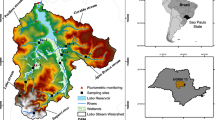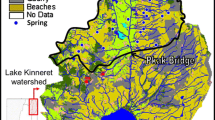Abstract
This paper presents results on nutrient concentrations estimations in the Upper Tombigbee watershed (northern Mississippi-Alabama region, USA). It details the hydrological model development and its use for providing stream flow, runoff, and nutrient concentrations (total phosphorus, TP, and total nitrogen, TN) for subsequent biological studies. Geographical locations of data collection on fish and mussel were used to perform a watershed delineation of the area of study. The delineated catchment was enriched with land use information from USGS GIRAS (1986) and NASA MODIS MOD12Q1 (2001-2004) datasets. An increase of 34% in agricultural lands is shown to have occurred from 1986 to 2003. The Hydrological Program Fortran (HSPF) was used for estimating stream flow and run-off rates for two hydrological models (one per each land use dataset). Export coefficients representative for the regions were used for estimating TN and TP concentrations. It is shown that only maximum concentrations of total nitrogen and total phosphorus have increased from 1986 to 2003. The percent increase ranges from 5 to 16% when comparing a sub-set of sub-basins, and 34% to 37% when taking into account all sub-basins. This seems to be consistent with the increase in agricultural areas in the same time period.
Access this chapter
Tax calculation will be finalised at checkout
Purchases are for personal use only
Preview
Unable to display preview. Download preview PDF.
Similar content being viewed by others
References
Vesterby, W., Krupa, K.S.: Major Uses of Land in the United States. Resource Economics Division, Economic Research Service. U.S. Department of Agriculture. Statistical Bulletin No. 973 (1997)
Allen, J.D.: Stream ecology: Structure and function of running waters. Chapman & Hall, Oxford (1995)
Karr, J.R., Chu, E.W.: Restoring life in running waters. Island Press, Washington (1999)
Liu, R., Yang, Z., Shen, Z., Yu, S.L., Ding, X., Wu, X., Liu, F.: Estimating nonpoint source pollution in the upper Yangtze River using the export coefficient model, remote sensing, and geographical information system. Journal of Hydraulic Engineering 135(9), 698–704 (2009)
Liu, R., He, M., Wang, X.: Application of the export coefficient model in estimating nutrient pollution of Dahuofang Reservoir Drainage Basin, Daliao River, China. In: 2nd International Conference on Bioinformatics and Biomedical Engineering, iCBBE, pp. 3645–3648 (2008)
Ierodiaconou, D., Laurenson, L., Leblanc, M., Stagnitti, F., Duff, G., Salzman, S.: Multi-temporal land use mapping using remotely sensed techniques and the integration of a pollutant load model in a GIS, vol. 289, pp. 343–352. IAHS-AISH Publication (2004)
Bicknell, B.R., Imhoff, J.C., Kittle, J.L., Jobes, T.H., Donigian, A.S.: HSPF Version 12 User’s Manual. National Exposure Research Laboratory. Office of Research and Development U.S. Environmental Protection Agency (2001)
NASA: MODIS MOD12 Land Cover and Land Cover Dynamics Products User Guide, http://www-modis.bu.edu/landcover/userguidelc/lc.html
Environmental Protection Agency: BASINS: Better Assessment Science Integrating Point & Nonpoint Sources: A Powerful Tool for Managing Watersheds, http://www.epa.gov/waterscience/BASINS/
Lin, J.P.: Review of Published Export Coefficient and Event Mean Concentration (EMC) Data. Wetlands Regulatory Assistance Program ERDC TN-WRAP-04-3 (September 2004)
Haobo Lin, H., Wang, J., Jia, X., Bo, Y., Wang, D.: Evaluation of MODIS land cover product of East of China, http://www.igarss08.org/Abstracts/pdfs/2400.pdf
Author information
Authors and Affiliations
Editor information
Editors and Affiliations
Rights and permissions
Copyright information
© 2010 Springer-Verlag Berlin Heidelberg
About this paper
Cite this paper
Alarcon, V.J., McAnally, W., Ervin, G., Brooks, C. (2010). Using MODIS Land-Use/Land-Cover Data and Hydrological Modeling for Estimating Nutrient Concentrations. In: Taniar, D., Gervasi, O., Murgante, B., Pardede, E., Apduhan, B.O. (eds) Computational Science and Its Applications – ICCSA 2010. ICCSA 2010. Lecture Notes in Computer Science, vol 6016. Springer, Berlin, Heidelberg. https://doi.org/10.1007/978-3-642-12156-2_38
Download citation
DOI: https://doi.org/10.1007/978-3-642-12156-2_38
Publisher Name: Springer, Berlin, Heidelberg
Print ISBN: 978-3-642-12155-5
Online ISBN: 978-3-642-12156-2
eBook Packages: Computer ScienceComputer Science (R0)




